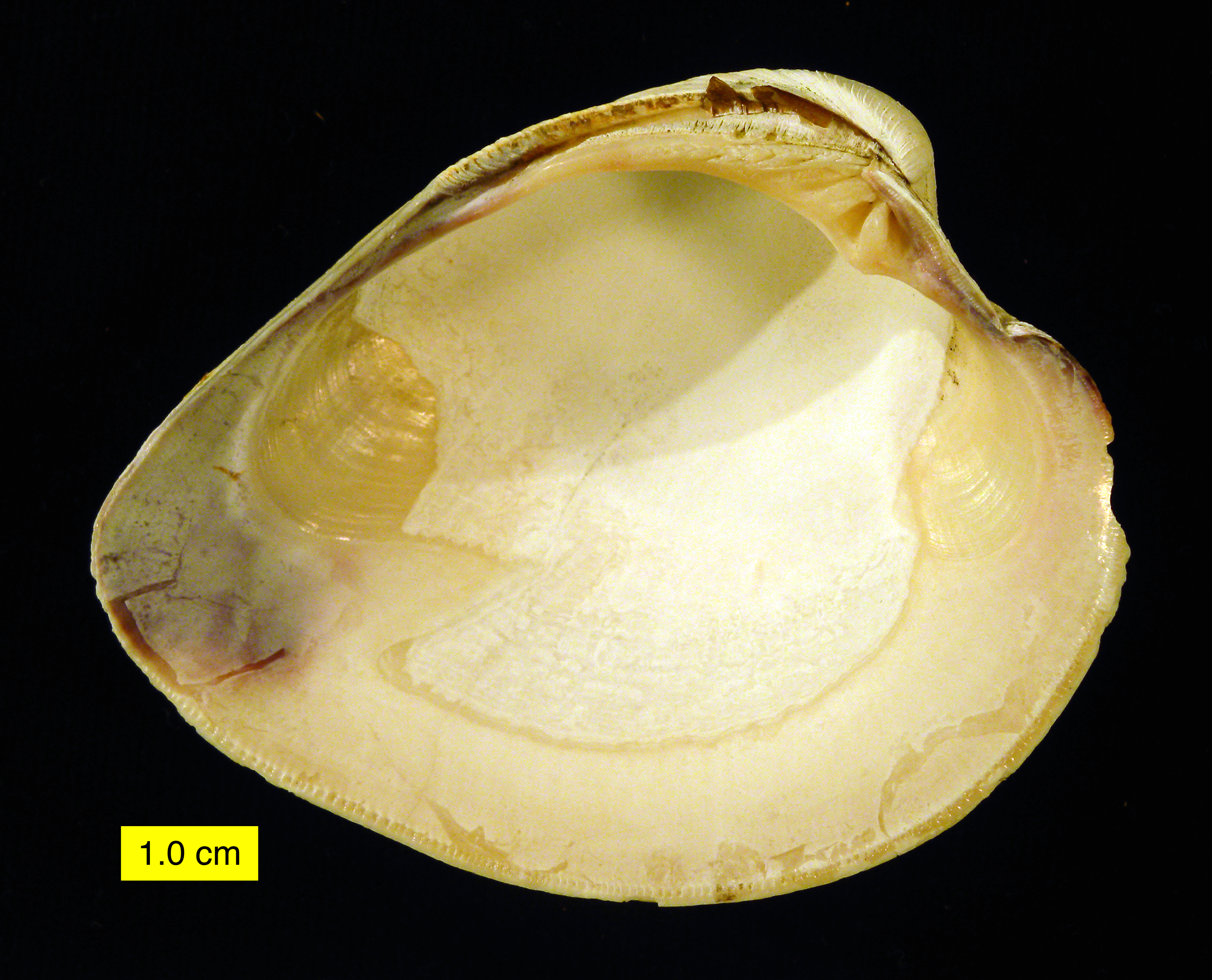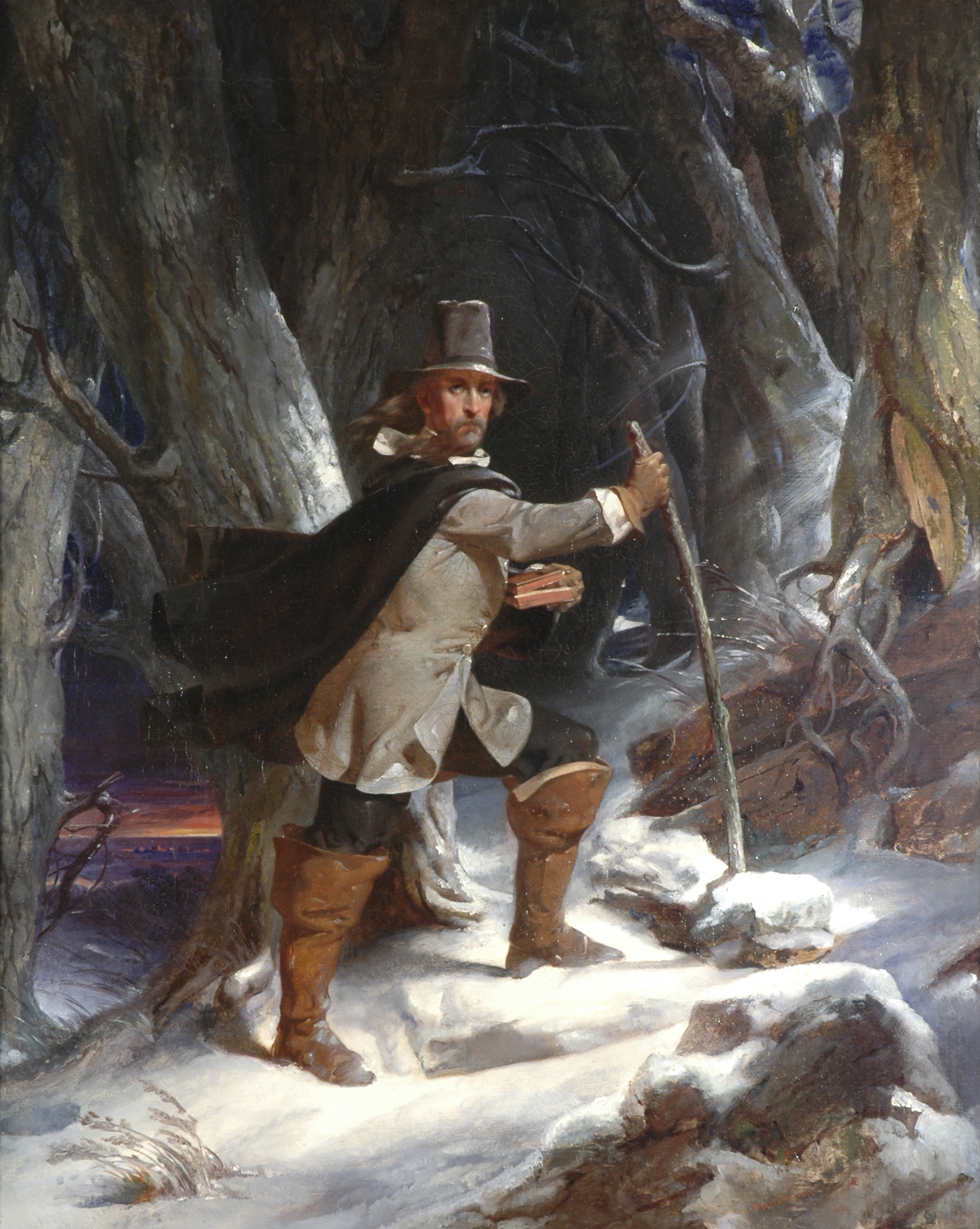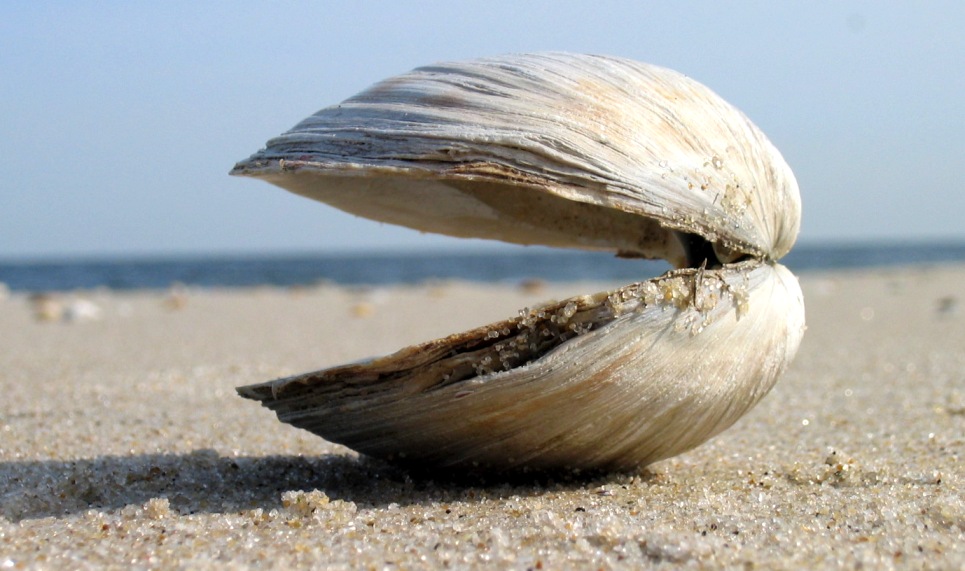|
Quahog
The hard clam (''Mercenaria mercenaria''), also known as the round clam, hard-shell (or hard-shelled) clam, or the quahog, is an edible marine bivalve mollusk that is native to the eastern shores of North America and Central America from Prince Edward Island to the Yucatán Peninsula. It is one of many unrelated edible bivalves that in the United States are frequently referred to simply as clams. Older literature sources may use the systematic name ''Venus mercenaria''; this species is in the family Veneridae, the venus clams. Confusingly, the "ocean quahog" is a different species, ''Arctica islandica'', which, although superficially similar in shape, is in a different family of bivalves: it is rounder than the hard clam, usually has a black periostracum, and there is no pallial sinus in the interior of the shell. Alternative names The hard clam has many alternative common names. It is also known as the Northern quahog, round clam, or chowder clam. In fish markets, there ar ... [...More Info...] [...Related Items...] OR: [Wikipedia] [Google] [Baidu] |
Mercenaria081111
''Mercenaria'' is a genus of edible marine bivalves in the family Veneridae, the Venus clams. The genus includes the quahogs, consisting of ''Mercenaria mercenaria'', the northern quahog or hard clam, and ''M. campechiensis'', the southern quahog, both important species for human consumption. Species The World Register of Marine Species accepts the following extant species as valid: * '' Mercenaria browni'' Petuch & Berschauer, 2019 * '' Mercenaria campechiensis'' (Gmelin, 1791) – Southern quahog * '' Mercenaria hartae'' Petuch, 2013 * '' Mercenaria mercenaria'' (Linnaeus, 1758) – Northern quahog * '' Mercenaria stimpsoni'' (Gould, 1861) – Stimpson's hard clam * '' Mercenaria texana'' (Dall, 1902) ''Mercenaria mercenaria'' and ''M. campechiensis'' can hybridise where their ranges overlap. Fossils species Several other species are known only from fossils. These mollusk are known since the Upper Oligocene (28.1–23.03 Ma). Fossil shells have been found in the sediments ... [...More Info...] [...Related Items...] OR: [Wikipedia] [Google] [Baidu] |
Arctica Islandica
The ocean quahog (''Arctica islandica'') is a species of edible clam, a marine (ocean), marine bivalve mollusc, mollusk in the family Arcticidae. This species is native to the North Atlantic Ocean, and it is harvested commercially as a food source. This species is also known by a number of different common names, including Icelandic cyprine, mahogany clam, mahogany quahog, black quahog, and black clam. The typical ''A. islandica'' resembles the hard clam, quahog, but the shell of the ocean quahog is rounder, the periostracum is usually black, and on the interior of the shell, the pallial line has no indentation, or pallial sinus, sinus. Unlike the quahog, which lives intertidal zone, intertidally and can be collected by clam digging, this species lives littoral zone, subtidally, and can only be collected by fishing dredge, dredging. They grow to sizes exceeding 50 mm or two inches shell height. Ming (clam), An individual specimen was reported to have lived 507 years, making ... [...More Info...] [...Related Items...] OR: [Wikipedia] [Google] [Baidu] |
Roger Williams
Roger Williams (March 1683) was an English-born New England minister, theologian, author, and founder of the Colony of Rhode Island and Providence Plantations, Providence Plantations, which became the Colony of Rhode Island and Providence Plantations and later the Rhode Island, State of Rhode Island. He was a staunch advocate for religious liberty, separation of church and state, and fair dealings with the Native Americans. Initially a Puritan minister, his beliefs evolved and he questioned the authority of the Puritan church in enforcing religious conformity. He was expelled by the Puritan leaders from the Massachusetts Bay Colony, and he established Providence Plantations in 1636 as a refuge offering what he termed "liberty of conscience" making Rhode Island the first government in the Western civilization, Western world to guarantee Freedom of religion, religious freedom in its founding charter. His ideas on religious tolerance and civil government directly influenced the ... [...More Info...] [...Related Items...] OR: [Wikipedia] [Google] [Baidu] |
Clam
Clam is a common name for several kinds of bivalve mollusc. The word is often applied only to those that are deemed edible and live as infauna, spending most of their lives halfway buried in the sand of the sea floor or riverbeds. Clams have two shells of equal size connected by two adductor muscles and have a powerful burrowing foot. They live in both freshwater and marine environments; in salt water they prefer to burrow down into the mud and the turbidity of the water required varies with species and location; the greatest diversity of these is in North America. Clams in the culinary sense do not live attached to a substrate (whereas oysters and mussels do) and do not live near the bottom (whereas scallops do). In culinary usage, clams are commonly eaten marine bivalves, as in clam digging and the resulting soup, clam chowder. Many edible clams such as palourde clams are ovoid or triangular; however, razor clams have an elongated parallel-sided shell, suggesting ... [...More Info...] [...Related Items...] OR: [Wikipedia] [Google] [Baidu] |
Bivalve
Bivalvia () or bivalves, in previous centuries referred to as the Lamellibranchiata and Pelecypoda, is a class (biology), class of aquatic animal, aquatic molluscs (marine and freshwater) that have laterally compressed soft bodies enclosed by a calcified exoskeleton consisting of a hinged pair of half-bivalve shell, shells known as valve (mollusc), valves. As a group, bivalves have no head and lack some typical molluscan organs such as the radula and the odontophore. Their gills have evolved into ctenidium (mollusc), ctenidia, specialised organs for feeding and breathing. Common bivalves include clams, oysters, Cockle (bivalve), cockles, mussels, scallops, and numerous other family (biology), families that live in saltwater, as well as a number of families that live in freshwater. Majority of the class are benthic filter feeders that bury themselves in sediment, where they are relatively safe from predation. Others lie on the sea floor or attach themselves to rocks or other h ... [...More Info...] [...Related Items...] OR: [Wikipedia] [Google] [Baidu] |
New England
New England is a region consisting of six states in the Northeastern United States: Connecticut, Maine, Massachusetts, New Hampshire, Rhode Island, and Vermont. It is bordered by the state of New York (state), New York to the west and by the Canadian provinces of New Brunswick to the northeast and Quebec to the north. The Gulf of Maine and Atlantic Ocean are to the east and southeast, and Long Island Sound is to the southwest. Boston is New England's largest city and the capital of Massachusetts. Greater Boston, comprising the Boston–Worcester–Providence Combined Statistical Area, houses more than half of New England's population; this area includes Worcester, Massachusetts, the second-largest city in New England; Manchester, New Hampshire, the largest city in New Hampshire; and Providence, Rhode Island, the capital of and largest city in Rhode Island. In 1620, the Pilgrims (Plymouth Colony), Pilgrims established Plymouth Colony, the second successful settlement in Briti ... [...More Info...] [...Related Items...] OR: [Wikipedia] [Google] [Baidu] |
Wampum
Wampum is a traditional shell bead of the Eastern Woodlands tribes of Native Americans. It includes white shell beads hand-fashioned from the North Atlantic channeled whelk shell and white and purple beads made from the quahog or Western North Atlantic hard-shelled clam. In New York, wampum beads have been discovered dating before 1510.Dubin, Lois Sherr. ''North American Indian Jewelry and Adornment: From Prehistory to the Present''. New York: Harry N. Abrams, 1999: 170–171. . Before European contact, strings of wampum were used for storytelling, ceremonial gifts, and recording important treaties and historical events, such as the Two Row Wampum Treaty and the Hiawatha Belt. Wampum was also used by the northeastern Indigenous tribes as a means of exchange, strung together in lengths for convenience. The process to make wampum was labor-intensive with stone tools. Only the coastal tribes had sufficient access to the basic shells to make wampum. These factors increased ... [...More Info...] [...Related Items...] OR: [Wikipedia] [Google] [Baidu] |
Wampanoag Language
The Massachusett language is an Algonquian language of the Algic language family that was formerly spoken by several peoples of eastern coastal and southeastern Massachusetts. In its revived form, it is spoken in four Wampanoag communities. The language is also known as or (Wampanoag), and historically as , Indian or . The language is most notable for its community of literate Native Americans and for the number of translations of religious texts into the language. John Eliot's translation of the Christian Bible in 1663 using the Natick dialect, known as '' Mamusse Wunneetupanatamwe Up-Biblum God'', was the first printed in the Americas, the first Bible translated by a non-native speaker, and one of the earliest examples of a Bible translation into a previously unwritten language. Literate Native American ministers and teachers taught literacy to the elites and other members of their communities, influencing a widespread acceptance. This is attested in the numerous court p ... [...More Info...] [...Related Items...] OR: [Wikipedia] [Google] [Baidu] |
Narragansett Language
Narragansett is an Algonquian language formerly spoken in most of what is today Rhode Island by the Narragansett people. It was closely related to the other Algonquian languages of southern New England like Massachusett and Mohegan-Pequot. The earliest study of the language in English was by Roger Williams, founder of the Rhode Island colony, in his book '' A Key Into the Language of America'' (1643). Name The word ''narragansett'' means, literally, '(people) of the small point'. The "point" may be located on the Salt Pond in Washington County. History Traditionally the tribe spoke the Narragansett language, a member of the Algonquian language family. The language became almost entirely extinct during the centuries of European colonization in New England through cultural assimilation. The tribe has begun language revival efforts, based on early-20th-century books and manuscripts, and new teaching programs. The Narragansett spoke a "Y-dialect", similar enough to the "N-d ... [...More Info...] [...Related Items...] OR: [Wikipedia] [Google] [Baidu] |
Periostracum
The periostracum ( ) is a thin, organic coating (or "skin") that is the outermost layer of the shell of many shelled animals, including molluscs and brachiopods. Among molluscs, it is primarily seen in snails and clams, i.e. in gastropods and bivalves, but it is also found in cephalopods such as ''Allonautilus scrobiculatus''. The periostracum is an integral part of the shell, and it forms as the shell forms, along with the other shell layers. The periostracum is used to protect the organism from corrosion. The periostracum is visible as the outer layer of the shell of many molluscan species from terrestrial, freshwater, and marine habitats, and may be seen in land snails, river mussels, and other kinds of freshwater bivalves, as well as in many kinds of marine shelled molluscs. The word ''periostracum'' means "around the shell", meaning that the periostracum is wrapped around what is usually the more calcareous part of the shell. Technically, the calcareous part of the sh ... [...More Info...] [...Related Items...] OR: [Wikipedia] [Google] [Baidu] |
Veneridae
The Veneridae or venerids, common name: Venus (mythology), Venus clams, are a very large family of minute to large, saltwater clams, marine bivalve molluscs. Over 500 living species of venerid bivalves are known, most of which are edible, and many of which are exploited as food sources. Many of the most important edible species are commonly known (in the USA) simply as "clams". Venerids make up a significant proportion of the world fishery of edible bivalves. The family includes some species that are important commercially, such as (in the USA) the hard clam or quahog, ''Mercenaria mercenaria''. Taxonomy The classification within the family Veneridae has been controversial at least since the 1930s. Molecular approaches show that much of this traditional classification is unnatural. Some common species have been moved between genera (including genera in different subfamilies) because of repeated attempts to bring a more valid organization to the classification or Taxonomy (biol ... [...More Info...] [...Related Items...] OR: [Wikipedia] [Google] [Baidu] |
A Key Into The Language Of America
''A Key into the Language of America'' or ''An help to the Language of the Natives in that part of America called New England'' is a book written by Roger Williams in 1643 describing the Native American languages in New England in the 17th century, largely Narragansett, an Algonquian language. The book is the first published colonial study of a Native American language in English. History Author Roger Williams was a Puritan who was banished from Massachusetts Bay Colony and founded Providence Plantations which grew into the Colony of Rhode Island. He believed that the king had no right to grant title to Indian land without paying for it. He interacted extensively with the Narragansett and Wampanoag tribes as a missionary, friend, and trader. He extolled some elements of Indian culture as superior to European culture, and he wrote a complementary poem at the end of each chapter within the book. According to J. Patrick Cesarini, Williams also published the book to rebut Massa ... [...More Info...] [...Related Items...] OR: [Wikipedia] [Google] [Baidu] |









